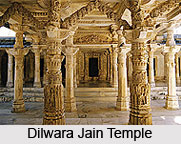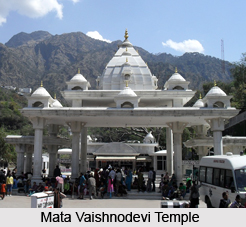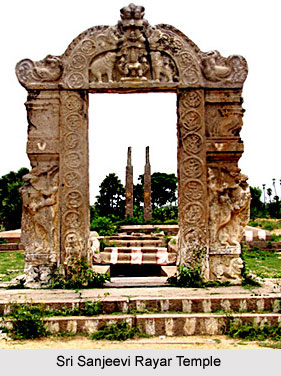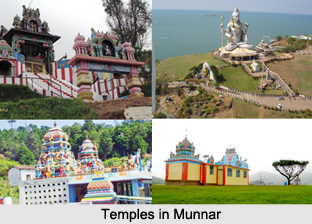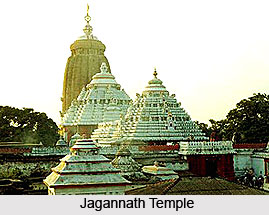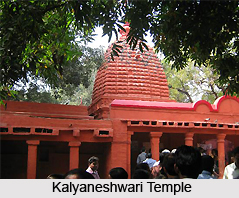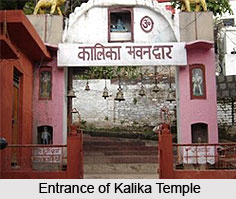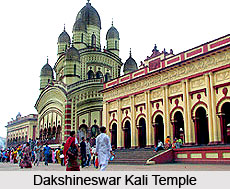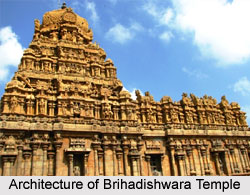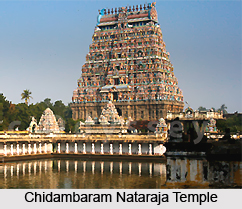 In the Chidambaram Temple of Tamil Nadu Lord Shiva is seen in the dancing posture of Ananda Tandavam. The form of Nataraja, the great dancer, has been a symbol of interpretation of the great truth of the Lord`s fivefold activities, Creation, Preservation, Destruction, Veiling and Blessing. This particular cosmic dance has been known as Nadanta Dance, Urdhwatandava Dance, Bhujangatrasa Dance and Anandatandava Dance.
In the Chidambaram Temple of Tamil Nadu Lord Shiva is seen in the dancing posture of Ananda Tandavam. The form of Nataraja, the great dancer, has been a symbol of interpretation of the great truth of the Lord`s fivefold activities, Creation, Preservation, Destruction, Veiling and Blessing. This particular cosmic dance has been known as Nadanta Dance, Urdhwatandava Dance, Bhujangatrasa Dance and Anandatandava Dance.
Lord Shiva is represented with three eyes, symbols of Sun, Moon and Fire and of time, past, present and future. The third eye is located between the eye-brows and is known as the Eye of Wisdom. He wears in his right ear a man`s earring (Makara-kundala) and on his left a woman`s (Tatunka or Todu) to indicate the combination of both male and female. He wears a necklace of skulls symbolising that he is lord of destruction, Samharamurti. He wears ashes on his body. Hence the use of ashes by his devotees as a sacrament, the symbol of purification by the fire of His grace, for each soul must lose the world to find God.
He also wears a necklace of rudrakshas, Shaivite devotees wear such beads. He also wears the Upavita, the sacred thread, over the left shoulder and under the right arm. The Upavita generally consists of 96 strands, representing the 96 Tattwas, categories or constituents of the Universe. No ritual can be celebrated without wearing the Upavita.
The drum in the right hand of Lord Shiva symbolises the fact that God holds the cause of the entire world, i.e., Sound (Sabda Nishtam Jagat), in his hand, to be folded or unfolded at His will. The very first sound OM has its origin from this drum.
One foot of the Lord is planted over the giant Muyalaka, i.e., Maha Maya (the endless illusion) which has been crushed, while the right foot raised up means renunciation or the fourth state of mind (Tureeya), which is beyond and above the 3 states of waking, dream and dreamless sleep, and leaves the mind, Maya and the world behind, The second right hand represents the idea of peace and bliss. On one of the left hands is held Agni, fire, symbolising the Jyoti of the Atman. The place of the dance, the theatre, is Tillai Vanam, the body of the individual self. The platform in that theatre is the cremation ground, the place where all passions, names and forms that constitute the visible world, are burnt away. The dancing pose teaches in a nutshell that Maya or illusion should be crushed down. The deer-like flitting mind should be controlled and Egoism (Ahankara) must be destroyed so that man can be a master of his inner self and enjoy the calmness, bliss and light of Truth.
Lord Shiva stands in a halo or a circle of flame. The circle issues from the mouth of a pair of dolphins (Makara). The halo symbolises Pranava, the mystic word (Om), the generalised symbol of all possible sounds, therefore the fittest symbol of the Logos (the Word of God incarnate).
The hair of the head is braided, the upper part tied to form a crown, the lower falling loose and whirling in the dance. At the base of the crown is a human skull, symbol of Shiva`s destroying energy. On the lower braid is a mermaid on the right, representing the Ganga River, symbol of fertility and of God`s grace. According to tradition the Ganga, the celestial river, was permitted by Shiva to descend on earth in answer to the prayers of King Bhagiratha, and the force of the fall was broken by Shiva by receiving it in his matted locks for a time, to save the earth from being crushed by the weight of the falling stream. On the loose braids on the left are the crescent Moon, symbol of Shiva`s grace and glory, symbol also of time, and a cobra which by its deadly venom may be taken as a symbol of destruction and obscuration, but here it is a symbol of the cosmic force-Kundalini.
The serpent represents the cosmic force in Shiva, the Supreme Yogi. According to Raja Yoga there runs through the spinal chord of man. A canal, called Sushumna, at the base of which is a plexus called Mooladhara and at the crown in the brain another called Sahasrara, thousand-petalled lotus. In the Mooladhara is stored the cosmic energy, one infinitesimal fraction of which is distributed through the body by the sensory and motor nerves through the Ida and the Pingala Nadis on either side of Sushumna. This canal, though existing in all animals, is closed except in the Yogi. He dispenses with the aid of the sensory and motor nerves and opens the canal and sends through it all mental currents, makes the body a signatic battery of the Will and raises the vast coiled-up power from the basic plexus to the thousand-petalled lotus in the brain, i.e., from Mooladhara to Sahashrara. As this power travels up the canal, higher and more wonderful powers of vision and knowledge are gained till the goal is reached of union with God.
The whole figure stands on a lotus referred to in connection with Kundalini Shakti. Thus the dance represents all the fivefold acts of God.












